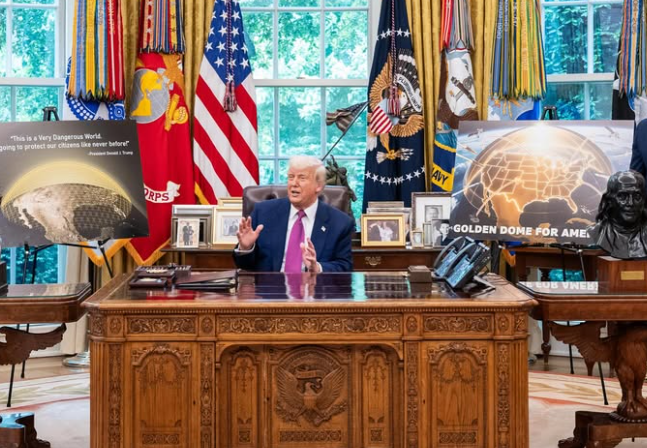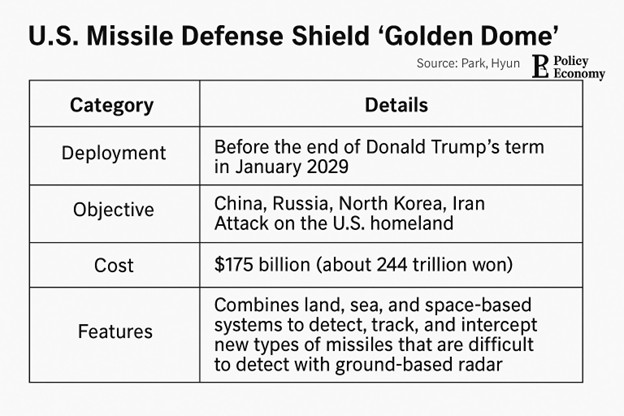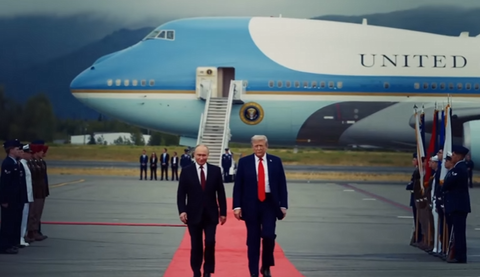“Blocking Missile Attacks with Satellites” — Trump Deploys 'Golden Dome' for Combat Use During His Term
Input
Changed
Reviving the ‘Star Wars Project’ A Next-Generation Defense System That Intercepts in Space Experts Warn: "It Could Cost Trillions of Dollars"

In a dramatic pivot to space-age defense strategy, U.S. President Donald Trump has announced a sweeping plan to deploy an advanced missile defense system—known as the Golden Dome—before the end of his current term. Modeled loosely on Israel’s Iron Dome but designed for an exponentially broader scope, the Golden Dome aims to intercept missiles launched from anywhere on Earth—and even from outer space—using an integrated system of satellites, artificial intelligence, and space-based interceptors. The initiative signals not only the militarization of space but also the revival of Reagan-era ambitions to make the United States invulnerable to foreign missile threats.
Trump’s announcement has ignited widespread debate. Supporters hail it as a bold reimagining of national defense in a multipolar era of rising threats from China, Russia, North Korea, and Iran. Critics, however, point to the astronomical costs, technical uncertainty, and potential conflicts of interest surrounding the project, especially with major contracts expected to go to Elon Musk’s SpaceX. Still, Trump has framed the Golden Dome as an American imperative—one that finishes what Ronald Reagan started.
USD 175 Billion to Fortify the Homeland Against Global Threats
On May 20 (local time), in a formal address from the Oval Office, Trump declared that the Golden Dome design had been completed. Beside him stood Defense Secretary Pete Hegseth, signaling full military backing for the project. “It must be fully operational before the end of my term,” Trump emphasized, adding that the Golden Dome would represent the next frontier of American deterrence, capable of detecting and intercepting missiles in all phases of flight—from land, sea, or space.
According to the president, the total construction cost will reach USD 175 billion, with USD 25 billion already embedded in the legislative framework of the “Big and Beautiful Omnibus Bill,” currently awaiting congressional approval. That bill reflects Trump’s broader budget and tax priorities and, if passed, would serve as a launchpad—both politically and financially—for Golden Dome implementation.
The administration sees the system as critical to countering evolving missile technologies from hostile states. China and Russia have both made significant advances in hypersonic missile development, while North Korea continues to test long-range ballistic missiles that could potentially target the U.S. mainland. Trump’s team believes the Golden Dome will redefine American missile defense, offering a near-impenetrable shield for the homeland at a time when global threats are diversifying and accelerating.

A Space-Based Shield to Intercept Even Orbital Missile Launches
While Israel’s Iron Dome has become a symbol of missile defense excellence, especially against short-range threats from Iran-backed groups like Hezbollah and Hamas, Trump’s Golden Dome envisions a more ambitious architecture. In January, the president signed an executive order to establish the system domestically. Unlike traditional radar-based platforms, the Golden Dome will rely on space-based sensors mounted on hundreds of satellites to track even the most elusive missile launches.
These sensors will identify and follow threats in real time, communicating with interceptors stationed not only on land and sea but also in orbit. The goal is to strike missiles during their boost phase, when they are most vulnerable. This conceptual framework closely resembles the Strategic Defense Initiative (SDI)—Reagan’s Cold War-era plan to deploy satellites and laser systems to shoot down Soviet ICBMs. Although SDI, nicknamed the “Star Wars” project, was ultimately canceled in 1993 due to feasibility and cost concerns, Trump has positioned the Golden Dome as a direct successor.
“We will truly complete the task President Reagan began 40 years ago—to end the threat of missile attacks on the U.S. homeland once and for all,” Trump declared. To realize that goal, the Golden Dome will incorporate cutting-edge technologies like artificial intelligence (AI) for autonomous threat detection and targeting. Trump also emphasized that interceptors in space would enable the U.S. to destroy even orbital missile threats—a response to the growing militarization of low-Earth orbit and the possibility of space-launched weapons.
The project also builds upon Trump’s earlier establishment of the U.S. Space Force, which he formed during his first term. While initially ridiculed by some critics, the Space Force has now become a crucial organizational backbone for Trump’s space-based defense ambitions. Golden Dome would serve as a force multiplier—turning Earth’s orbit into a strategic theater of deterrence.
Technical Challenges, Sky-High Costs, and Controversy Over Contracts
Despite the administration’s bold rhetoric, technical and financial experts remain skeptical about the feasibility of launching such a sophisticated system within Trump’s current term—or even the decade ahead. Developing technology to intercept missiles in space, particularly during the midcourse or boost phase, involves unprecedented complexity. Systems would require not only highly sensitive tracking but also high-energy lasers or directed microwaves to neutralize targets moving at thousands of miles per hour.
Even Israel’s Iron Dome, as effective as it is, has primarily intercepted slow, short-range, unguided projectiles. In contrast, Golden Dome must detect and destroy advanced intercontinental ballistic missiles (ICBMs) and potentially hypersonic glide vehicles, which maneuver unpredictably and travel at Mach 5 or higher. These requirements elevate both the engineering challenge and the associated cost.
Although Trump has priced the system at USD 175 billion, independent analysts suggest a much higher figure. Defense experts estimate the cost could range from several hundred billion to multiple trillions of dollars. The U.S. Congressional Budget Office (CBO) projects that building and maintaining a space-based missile interception infrastructure would demand USD 542 billion over the next 20 years—a number that could increase further with technology upgrades and maintenance.
There is also the question of procurement and transparency. A significant portion of the Golden Dome project is expected to be awarded to SpaceX, the private aerospace company founded by Elon Musk, one of Trump’s closest business allies. This has already raised concerns about conflicts of interest and the lack of competitive bidding in what may become the most expensive defense contract in American history.
Finally, some critics point to history as a cautionary tale. Even after 32 years since the cancellation of SDI, many of the same technological roadblocks remain. Directed-energy weapons and mid-flight interception from space still elude reliable implementation. The race to realize the Golden Dome may thus depend not only on funding and political will, but on whether science can catch up with strategy.





















